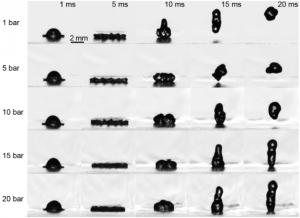Modern internal combustion engines power military ground transportation and unmanned air vehicles (UAV). But in certain operating conditions fuel drops can significantly impinge on the engine piston surface of these engines, affecting the fuel mixture distribution and performance – and the success of missions.
Song-Charng Kong, professor of mechanical engineering, and James Michael, assistant professor of mechanical engineering, are working with the Army Research Laboratory to develop high-fidelity computational models that predict drop-wall interactions. They also conduct experiments to validate the models that they develop.
Currently, researchers struggle to accurately predict the outcomes of drop-wall interactions, particularly when nontraditional fuels, such as those of interest for the military, are used.
The objective of Kong and Michael’s project is to advance the fundamental understanding of the complex spray-wall interaction phenomena by using direct numerical simulation (DNS).
This fundamental knowledge will lead to the creation of an accurate computational tool capable of predicting fundamental details of drop-wall interactions in spray combustion systems. These simulations can then be used to design more effective engines with means of countering the effects of drop-wall interactions.
Not only will the proposed DNS be useful to the U.S. military, the approach will also be applicable to other industrial systems involving sprays, such as gas turbine engines, painting, cooling, fire suppression, and various types of chemical and material processing.
Kong and Michael’s work is interdisciplinary in nature because it involves multiphase fluid dynamics and heat transfer occurring in a combustion system, which means this project fits the mission of the Iowa State’s new Center for Multiphase Flow Research and Education (CoMFRE).
“CoMFRE provides the opportunity for me and graduate students to interact with other researchers,” Kong said. “Such interactions are key to successfully taking on complex multiphase flow challenges like these.”
| The local pressure results in different outcomes when fuel drops collide with hot walls, such as those encountered in UAV engines.
These snapshots are taken at set times to demonstrate the difference between the results at each pressure. |
